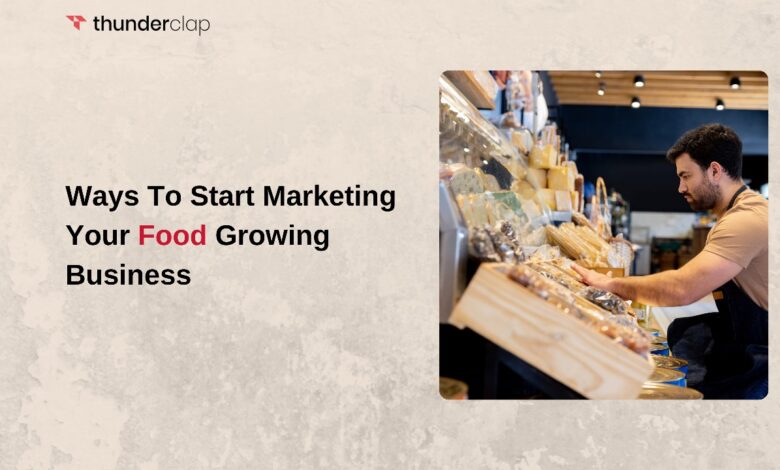10 Ways To Start Marketing Your Food-Growing Business

In today’s dynamic market, where consumer interest in farm-fresh produce and sustainable agriculture is improving, having diverse marketing channels is not just beneficial but imperative.
Did you know the global organic food market will reach $446 billion by 2030? For your food-growing company, reaching your target audience effectively means strategically embracing social media, local markets, and online platforms.
Here is a perfect blog that will help you market your food-growing business seamlessly on Instagram. You can also consider buying Instagram Followers for instant growth and a better presence.
Let’s get started with the perfect marketing strategies.
Strategic Ways for Marketing Your Food-Growing Business
Here are the best strategies for marketing your food-growing business:
Strategy 1: Craft a Compelling Brand Story
Create a compelling story that embodies your farm’s ideals and dedication to excellence. Put a strong emphasis on sustainability and community impact to connect with customers more deeply.
Writing a story that embodies your farm’s ideals and dedication to excellence requires including anecdotes about sustainable farming methods and their beneficial effects on the environment and neighborhood.
If you emphasize process openness and highlight the individuals who run your farm, customers who value eating ethically and locally sourced food will become your most devoted supporters. This story will help you stand out from the competition and connect more deeply with clients who have similar values.
Strategy 2: Create a Professional Website
Create an easily navigable website highlighting your farm’s history, merchandise, and ordering possibilities. Add client endorsements and top-notch photos to foster trust and boost e-commerce purchases.
Make sure your website is easy to use, with straightforward, intuitive navigation, a responsive design that functions well on both desktop and mobile devices, and high-quality photographs and testimonials.
To further engage shoppers with your brand narrative, include a blog or news section that provides frequent updates on farm operations, seasonal offers, and sustainable practices.
Strategy 3: Utilize Social Media Platforms Effectively
Share food updates, recipes, and direct consumer interaction on social media sites like Facebook and Instagram. Use images to showcase your agricultural methods and establish a genuine connection with your community.
By regularly sharing your farming methods and quickly answering questions and comments, you can build a devoted fan base and position your farm as an approachable and transparent brand in the digital sphere.
Strategy 4: Engage with Local Communities
Establish collaborations with nearby nonprofits or ecological associations to harmonize your farm’s principles with community demands, augmenting your company’s social accountability.
By supporting or organizing product-showcasing events, you may engage directly with prospective clients and demonstrate your dedication to the community’s economy and environment.
These initiatives increase exposure and solidify the loyalty and confidence of local customers, who value companies that actively support community welfare.
Strategy 5: Offer Educational Workshops and Classes
Inform customers about regional food’s advantages, sustainable practices, and culinary skills. Promote your farm as a resource for information and build trust with customers who care about the environment.
Provide seminars or online courses that impart practical knowledge, such as seasonal culinary techniques or gardening advice, showcasing your farm’s produce and proving your expertise in sustainability.
Post educational articles or films on your website and social media channels to attract a larger audience interested in eco-friendly methods and locally produced food.
Strategy 6: Partner with Local Restaurants and Markets
Work with market managers and chefs to include your goods on their menus and stands. This will increase your recognition and reputation in the neighborhood restaurant scene while reaching out to new clientele.
To encourage chefs and market managers to include your food in their offers, host chef demos or tasting events highlighting its quality and adaptability.
Strategy 7: Implement Sustainable Practices
To inform and interest your audience, provide in-depth articles and updates on your sustainable practices on your website and social media accounts. To bolster your reputation and demonstrate your commitment to environmentally sustainable farming, highlight your certifications or alliances with environmental groups.
Transparently demonstrating your dedication to sustainability can help you attract and retain clients who value making morally and ecologically conscious food choices.
Strategy 8: Attend Farmers’ Markets and Events
Present your goods to customers face-to-face at neighborhood gatherings and farmers’ markets. Make human contacts, get input, and adjust to market demands and client preferences.
At your stand, provide samples and culinary demos to attract potential clients and showcase your merchandise’s high caliber and adaptability. Gather participants’ contact information for a newsletter that will notify them of your farm’s most recent products and activities, encouraging continued participation and allegiance.
Strategy 9: Start a Community Supported Agriculture (CSA) Program
Start a membership service that gives local customers access to seasonal vegetable shipments. Encourage community involvement, maintain steady revenue, and supply members with fresh, wholesome produce directly from your farm.
To encourage clients and improve their experience with your farm’s products, include a variety of vegetables in each box along with cooking suggestions. To enhance members’ connection to your farm and community, give them unique events and farm visits, among other special benefits.
Strategy 10: Collaborate with Food Bloggers and Influencers
Collaborate with influencers to spread the word about your farm’s sustainable methods, recipes, and goods to their audience. Use their authority and influence to broaden your consumer base, draw in new clients, and raise your brand’s profile within the culinary industry.
Encourage influencers to sample your items by offering special discounts or promotions, which will generate immediate interest and create a feeling of urgency among their followers.
Conclusion: Start Marketing Strategically And Grow Your Business
Launch an innovative marketing campaign and see your food-growing company take off. Create an exciting brand narrative, participate in your community, and utilize contemporary digital technologies to establish trusting connections and attract devoted clients.
Apply these tactics to build your farm’s reputation as a reliable, sustainable source of fresh products and increase its exposure.




